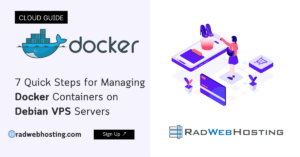
Docker has revolutionized the software development industry by making it possible to package applications into containers. This guide provides 7 quick steps for managing Docker containers on Debian VPS servers. It is designed for system administrators and developers who are familiar with basic Linux commands and concepts.
Docker simplifies the deployment of applications. Containers, which include all necessary executables, binary code, libraries, and configuration files, help create lightweight, secure environments. They ensure consistency across multiple development, testing, and production environments.
Unlike virtual machines (VMs) that require a full-blown operating system, Docker containers share the host OS system kernel and are therefore more resource-efficient.
sudo apt update
sudo apt upgrade -y
sudo apt install apt-transport-https ca-certificates curl software-properties-common -y
curl -fsSL https://download.docker.com/linux/debian/gpg | sudo apt-key add -
sudo add-apt-repository "deb [arch=amd64] https://download.docker.com/linux/debian $(lsb_release -cs) stable"
sudo apt update
sudo apt install docker-ce docker-ce-cli containerd.io -y
sudo systemctl status docker
sudo usermod -aG docker ${USER}
su - ${USER}
docker run -d -p 80:80 docker/getting-started
This command downloads a test image and runs it in a detached mode.
docker start CONTAINER_IDdocker stop CONTAINER_IDdocker rm CONTAINER_IDdocker exec -it CONTAINER_ID /bin/bash
docker imagesdocker rmi IMAGE_ID# Use an official Python runtime as a parent image
FROM python:3.7-slim
# Set the working directory to /app
WORKDIR /app
# Copy the current directory contents into the container at /app
ADD . /app
# Install any needed packages specified in requirements.txt
RUN pip install --trusted-host pypi.python.org -r requirements.txt
# Make port 80 available to the world outside this container
EXPOSE 80
# Define environment variable
ENV NAME World
# Run app.py when the container launches
CMD ["python", "app.py"]
docker build -t my-python-app .
docker run -p 6000:6379 redis
This command maps port 6379 inside the container to port 6000 on your Debian VPS.
docker run -d --name redis redis
docker run -d --name myapp --link redis myapp
docker-compose.yml file: version: '3'
services:
web:
build: .
ports:
- "5000:5000"
volumes:
- .:/code
depends_on:
- redis
redis:
image: "redis:alpine"
docker-compose up
READ ALSO: Top 12 Best VPS Control Panels
docker run -d \
--name devtest \
-v myvolume:/app \
nginx:latest
docker swarm init
docker swarm join --token SWMTKN-1-0xq4siwj5sargflkd6fs3zqr2z3caasciu9e8v3ttz3wimwxhw-8xw3zf6g0phkw8iwqrmnemrvk 192.168.99.100:2377
Managing Docker containers on a Debian VPS is efficient and effective once you grasp the basics. Through this guide, you have learned how to install Docker, run containers, manage their lifecycles, handle images, establish network communications between containers, and utilize Docker’s advanced features. With these skills, you can maintain a robust, secure, and high-performance Docker environment on your Debian VPS.
This article provides a guide for server administrators who want to install ISPConfig on VPS server with Virtualizor. What is… Read More
In this article, we'll discuss how to backup WordPress site to Google Drive using Softaculous. For this you'll need to… Read More
We've compiled our annual list of top 10 Best Open Source Shopping Carts. Our rankings are based on self-hosted shopping… Read More
VPS Hosting provides an upgrade from shared hosting with added scalability not available elsewhere. With root access and dedicated IP… Read More
In this guide, we will provide our list of the top 5 best free VPS control panel alternatives. Management of… Read More
💡 Did you know that WordPress powers over 35% of all websites on the internet? With its popularity, it's crucial… Read More